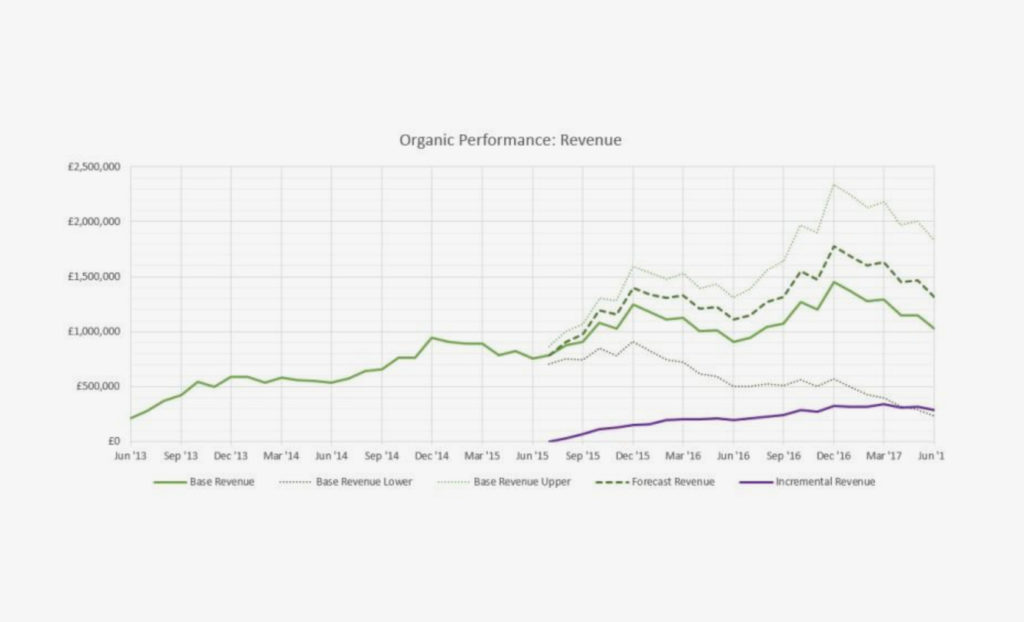Developing the business case for implementing SEO recommendations

Making changes to a website costs money, making significant changes can require a significant investment. Across the majority of SEO projects I’ve worked on over the last 14 years, SEO tends to be retrofitted to websites. So to facilitate changes the ecommerce manager or digital marketing manager will be required to provide a business case to get budget sign off, and rightly so.
At QueryClick we frequently receive questions like “what is that change likely to drive?” normally in relation to revenue but sometimes in relation to rankings and traffic depending on the project. To get things done, it’s important to tie a revenue figure to proposed changes.
I know from past experience that it can be a challenge to convince MDs, CFOs, Marketing Directors or other budget holders of the SEO impact on the bottom line. Quantifying the value that SEO can deliver can be a challenge, especially when optimisations are seldom implemented in isolation and in many cases take time to deliver results. It can be especially challenging on large ecommerce sites where there will likely be a busy development pipeline with a queue of prioritised change requests. So how do you jump the queue? With a strong business case.
Start With Data
We’re a data-driven search marketing agency so, that’s right, we start with the data. If you’ve got accurate historic analytics data, your ecommerce tracking is robust, and you’ve got some knowledge about future plans you can work towards building out a forecast.
“Forecasting is about predicting the future as accurately as possible, given all of the information available, including historical data and knowledge of future events.”
Forecasting: Principles and Practice by Rob J. Hyndman, George Athanasopoulos
At QueryClick we use an autoregressive integrated moving average (ARIMA)model for forecasting, see an example below:

Firstly, we plug in the historic Analytics data (run the numbers), then we factor in the growth opportunities our team have identified from conducting benchmark and audit work (tweak the uplift). We estimate growth against the initiatives we’re proposing in a granular way. This covers content optimisations, keyphrase opportunities, technical improvements, conversion optimisations and backlink growth potential, and is based on performance we’ve seen from implementing changes historically.
This way we can estimate growth potential based on the core improvements / initiatives tying a pounds and pence figure to the overall SEO strategy over a two-year period.
If you haven’t come across it yet Excel have a FORECAST function which means that you can start to create forecasts.
Look To The Future
It’s essential to incorporate the “knowledge of future events” part of the statement above, and when we produce a forecast it needs to take into account information from the client. We can and do make assumptions (detailed within the forecast), however if there are plans that we’re unaware of it impacts the accuracy, so this should be a collaborative process with the client. For example, if we don’t know about future plans for migrating to a new platform we can’t factor this milestone in to the forecast.
Know Your Numbers
I’m a Dragons Den fan (the team at QC know this as I’ve done Dragons Den themed team building exercises), and I’ve found myself shouting at the TV when someone comes in to pitch and they don’t know their numbers. That’s a sure-fire way to qualify yourself out of any chance of investment.
Similarly, you also need to know your numbers! They have to align with targets and the accepted metrics used by the business. If you’re not on the same page and talking the same language as the CFO, MD, etc. then you’ll struggle to get investment. Make sure that you validate the numbers and targets, and clearly understand the metrics that matter to the business.
Packaging
Another way to help your case along is to package it in a way that it’s easy for stakeholders to agree to. As an agency, we work with clients to get a clear understanding of the process:
- What information is required?
- What format does it need to be presented in?
- Who needs to sign off the business case?
- How do change requests need to be submitted?
- What’s in the development pipeline, and is there crossover with what we’re proposing?
In my experience, the best performing projects are the ones clearly focused on business objectives with a clear understanding of priorities. In addition to getting changes implemented, the team can then direct effort to the areas that will benefit the business the most at the right times, and if you can demonstrate this you’ll be well on your way to getting buy-in from key stakeholders.
Own your marketing data & simplify your tech stack.
Have you read?
Generative AI is transforming the way that marketers plan and assemble content for their Paid Ads. As big platforms like Google, Meta and TikTok increasingly build the tools needed to...
In a surprising move that has sparked heated debate, Mark Zuckerberg announced on his Instagram that Meta will be reducing its levels of censorship and in particular fact-checking on its...
It is no understatement to say that the impact of AI in marketing is huge right now. Here we take a look at some of the top uses cases that...


